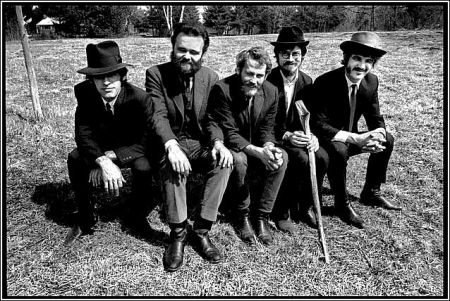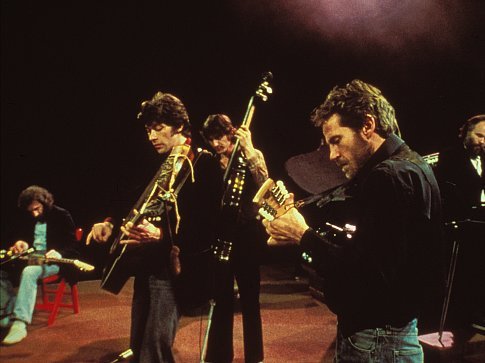
The Band: Richard Manuel, Garth Hudson, Levon Helm, Robbie Robertson & Rick Danko
There were not that many performers whose beginning was as shrouded in mystery as that of The Band. They were known as Bob Dylan’s backing group during his early electric tours, and they were in fact the ones backing the master onstage during the infamous “Judas!” incident. They issued their first album in 1968 (“Music From Big Pink”), and the cover illustration was actually done by Dylan. After the album was issued, they gave no interviews. And a twist of fate dictated that they were not to perform live for some time since one of their members (Rick Danko) was involved in a car accident that left him out of business for a couple of months.
One of their most popular songs, from “Music From Big Pink”:
Gradually, the mystery was lifted and what we found was an ensemble of musicians that redefined the concept of collectiveness, and the idea of a performing unit taken as a whole. Their second, eponymous album was a major step forward. Released in 1969, it is now regarded as a seminal work in the history of Rock & Roll.
Upon its release, everybody knew who they were and the way they operated. The names of the five members of The Band were on the lips of everybody within the scene and the industry: Robbie Robertson, Richard Manuel, Rick Danko, Levon Helm and Garth Hudson. With the exception of Robertson, everybody could play multiple instruments. Three members also handled lead vocals: Manuel, Danko and Helm. Still, Manuel is traditionally considered “the” lead singer of the group.
Epochal songs dealing with American themes (like “The Night They Drove Old Dixie Down”) constituted the backbone of that breakthrough album, and that was all the more remarkable since all of them (except for Helm) were Canadians.
The albums that succeeded had The Band gradually expanding their sound by approaching producers like Todd Rundgren, and working on elaborate arrangements with New Orleans musician Allen Toussaint among others. And their penultimate record together (“Northern Lights – Southern Cross”) offered a truly updated sound thanks to the addition of synthesizers into the mix.

The Band Performing Live At "The Last Waltz" Concert
As good as they were, those albums began showcasing some strains and rivalries within the group, as Robertson emerged as an authoritative figure – he took the credit for most of their compositions, and that caused serious problems in the long run, with other members accusing him of claiming authorship of what was essentially a collective effort. Robertson would be the first member to quit – his last performance with The Band was on the famed concert movie “The Last Waltz” in 1978.
The remaining members carried on, retaining their popularity with critics and fellow musicians but playing at smaller venues. Tragically, Richard Manuel took his own life in 1986. His story with substance abuse went way back, and the death of The Band’s manager Albert Grossman was a terrible blow to him at a time when he was slowly beginning to leave his addictions behind.
The Band continued as best as it could, and it issued three more albums over the years: Jericho (1993), High On The Hog (1996) and Jubilation (1998). But the untimely death of Rick Danko in 1999 was the end of it all. He was aged 56, and he had battled addictions (heroin) ever since his car accident in the late ‘60s.
In retrospect, The Band has always been more popular with critics and musicians than with the public at large. Few performers were praised so extensively by Rolling Stone, for example, and their legacy lives on in the works of everybody from Neil Young and Joni Mitchell to Fairport Convention.
If you had to capture The Band’s essence in a word, that would be “teamwork”. As mentioned above, four members rotated positions extensively until they arrived at the best arrangement for a song. (Many CD rereleases come with alternate takes where each member is playing a different instrument from the “official” take.) And while it is true that they did not have a standout soloist, they certainly could pull it off. Richard Manuel in particular was unmistakable behind the skins. He was primarily a pianist, and when playing the drums he sounded as if he were fighting single-handedly against a Goliath, with everything to lose. But as the song ended a kind of truce had been reached… until the next time they met.
When all is said and done, there were not that many musicians through history that pushed the boundaries of collaboration as extensively as The Band, and with results that were so easy to like and (above all) so inspirational. That they are so adored by musicians comes as no surprise. But it doesn’t take that much for a lover of music to become hooked. Not at all…

Pingback: The Band (Album Review) | MusicKO